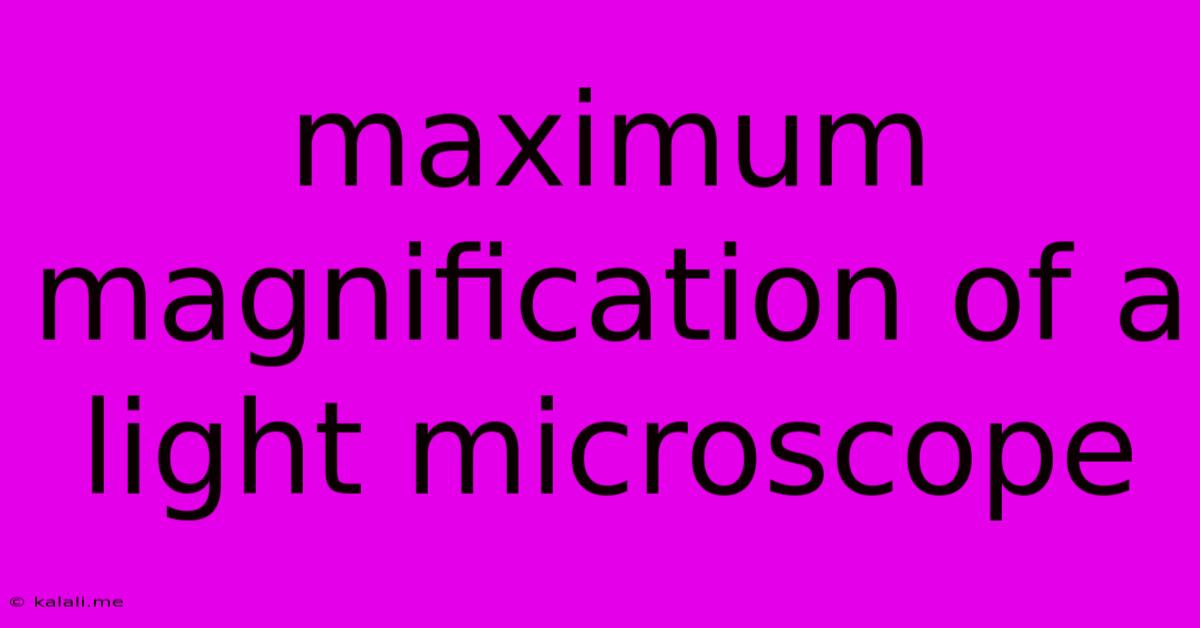Maximum Magnification Of A Light Microscope
Kalali
May 19, 2025 · 3 min read

Table of Contents
Maximum Magnification of a Light Microscope: Understanding the Limits of Resolution
The quest for ever-greater magnification has been a driving force in microscopy. While electron microscopes can achieve magnifications far exceeding those of light microscopes, understanding the maximum magnification achievable with a light microscope, and the factors limiting it, is crucial for anyone working with optical microscopy techniques. This article will explore the theoretical and practical limits of magnification in light microscopy, delving into resolution, numerical aperture, and the impact of lens quality.
What is Magnification? Magnification refers to the ability of a microscope to enlarge the image of a specimen. It's a crucial aspect of microscopy, allowing us to visualize structures invisible to the naked eye. However, simply increasing magnification isn't enough; the image must also be clear and detailed. This brings us to the concept of resolution.
Resolution: The Key to a Meaningful Image
Resolution, not magnification, is the critical factor determining the quality of a microscopic image. Resolution is the ability to distinguish between two closely spaced objects as separate entities. No matter how much you magnify a blurry image, it will remain blurry. The theoretical limit of resolution in a light microscope is determined by the wavelength of light used and the numerical aperture (NA) of the objective lens.
The Abbe Diffraction Limit
Ernst Abbe's diffraction limit formula describes this relationship:
d = λ / (2 * NA)
where:
- d represents the minimum resolvable distance between two points.
- λ represents the wavelength of light.
- NA represents the numerical aperture of the objective lens.
This formula shows that a smaller minimum resolvable distance (better resolution) is achieved with shorter wavelengths of light and higher numerical apertures.
Numerical Aperture (NA): A Measure of Light-Gathering Ability
The numerical aperture (NA) of an objective lens is a measure of its ability to gather light and resolve fine details. A higher NA means a greater ability to resolve fine structures. The NA is determined by the refractive index of the medium between the lens and the specimen (usually air or oil) and the angle of the light cone entering the objective lens. Oil immersion objectives, for example, have a higher NA than air objectives because oil has a higher refractive index than air.
Practical Limitations Beyond the Theoretical Limit
While the Abbe diffraction limit defines the theoretical resolution limit, practical limitations exist:
- Lens Aberrations: Imperfections in the lens system can reduce image quality and effective resolution, even if the theoretical limit is not reached. High-quality, well-corrected lenses are essential for achieving optimal resolution.
- Specimen Preparation: Poorly prepared specimens can introduce artifacts that obscure detail and reduce effective resolution.
- Light Source Quality: An inadequate light source can lead to insufficient illumination and reduce the quality of the image.
Maximum Useful Magnification
The maximum useful magnification is generally considered to be around 1000x the numerical aperture of the objective lens. Exceeding this limit results in "empty magnification," where the image is enlarged but no further detail is resolved. The image simply becomes larger but not clearer.
Types of Light Microscopes and Their Magnification Capabilities
Different types of light microscopes offer varying magnification capabilities. While a standard bright-field microscope typically offers magnifications in the range of 40x to 1000x, specialized techniques such as confocal microscopy can achieve higher effective resolution, albeit with limitations on the field of view.
Conclusion
While the theoretical magnification of a light microscope is essentially unlimited, the useful magnification is constrained by the resolution limit set by the wavelength of light and the numerical aperture of the objective lens. Understanding these limitations is crucial for selecting appropriate microscopy techniques and interpreting microscopic images accurately. Optimizing the entire imaging system, from lens quality to specimen preparation, is essential for achieving the best possible resolution and maximizing the usefulness of magnification.
Latest Posts
Latest Posts
-
Do You Need Xbox Live To Play Minecraft
May 19, 2025
-
Cannot Execute Binary File Exec Format Error
May 19, 2025
-
Bank 1 And Bank 2 Sensor
May 19, 2025
-
How Much Does A Garlic Clove Weigh
May 19, 2025
-
Can You Start A Sentence With You
May 19, 2025
Related Post
Thank you for visiting our website which covers about Maximum Magnification Of A Light Microscope . We hope the information provided has been useful to you. Feel free to contact us if you have any questions or need further assistance. See you next time and don't miss to bookmark.